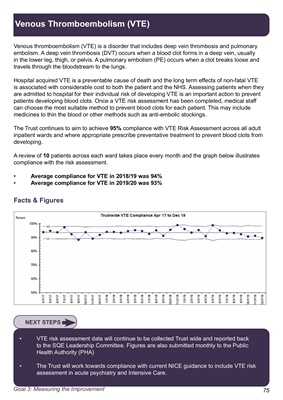
Venous Thromboembolism (VTE)
Facts & Figures
Venous thromboembolism (VTE) is a disorder that includes deep vein thrombosis and pulmonary
embolism. A deep vein thrombosis (DVT) occurs when a blood clot forms in a deep vein, usually
in the lower leg, thigh, or pelvis. A pulmonary embolism (PE) occurs when a clot breaks loose and
travels through the bloodstream to the lungs.
Hospital acquired VTE is a preventable cause of death and the long term effects of non-fatal VTE
is associated with considerable cost to both the patient and the NHS. Assessing patients when they
are admitted to hospital for their individual risk of developing VTE is an important action to prevent
patients developing blood clots. Once a VTE risk assessment has been completed, medical staff
can choose the most suitable method to prevent blood clots for each patient. This may include
medicines to thin the blood or other methods such as anti-embolic stockings.
The Trust continues to aim to achieve 95% compliance with VTE Risk Assessment across all adult
inpatient wards and where appropriate prescribe preventative treatment to prevent blood clots from
developing.
A review of 10 patients across each ward takes place every month and the graph below illustrates
compliance with the risk assessment.
• Average compliance for VTE in 2018/19 was 94%
• Average compliance for VTE in 2019/20 was 93%
• VTE risk assessment data will continue to be collected Trust wide and reported back
to the SQE Leadership Committee. Figures are also submitted monthly to the Public
Health Authority (PHA)
• The Trust will work towards compliance with current NICE guidance to include VTE risk
assessment in acute psychiatry and Intensive Care.
NEXT STEPS
Goal 3: Measuring the Improvement 75